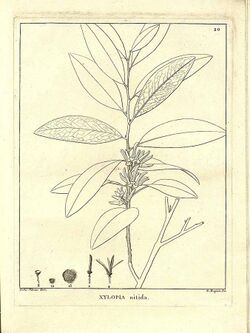Biology:Xylopia nitida
| Xylopia nitida | |
|---|---|

| |
| Botanical illustration of Xylopia nitida | |
| Scientific classification | |
| Kingdom: | Plantae |
| Clade: | Tracheophytes |
| Clade: | Angiosperms |
| Clade: | Magnoliids |
| Order: | Magnoliales |
| Family: | Annonaceae |
| Genus: | Xylopia |
| Species: | X. nitida
|
| Binomial name | |
| Xylopia nitida | |
| Synonyms | |
|
Unona concolor Willd. | |
Xylopia nitida is a species of plant in the Annonaceae family. It is native to Brazil , Colombia, Ecuador French Guiana, Guyana, Suriname and Venezuela.[2] Michel Félix Dunal, the botanist who first formally described the species, named it after the shiny (nitidus in Latin) upper surface of its leaves.[3][4]
Description
It is a tree reaching 20 meters in height. The young branches are covered in dense pale brown hairs, but as they mature they become hairless. Its narrow, elliptical, papery leaves are 8.5-13 by 3-4.5 centimeters. The leaves have pointed bases and tapering tips, with the tapering portion 5-10 millimeters long. The leaves are shiny and hairless on their upper surfaces, and have dense, slivery-white to brown hairs that lay flat on their lower surfaces. Its petioles are 2-6 millimeters long. Its Inflorescences occur in the axils of leaves or fallen leaves. Each inflorescence has up to 8 flowers. Each flower is on a pedicel that is 1-13 by 1-3 millimeters. Its flowers have 3 oval to triangular sepals that are 1-2 millimeters long. The lower part of the sepals are fused at their margins to form a cup-shaped calyx that is 4-5 millimeters long. Its 6 petals are arranged in two rows of 3. The orange outer petals are 18-20 by 3-5 millimeter. The orange inner petals are 15 by 1-2 millimeters. Its flowers have 170-270 stamen that are 1-1.5 millimeters long. The stamen are attached to a receptacle that forms a cone that is 1.8-2.2 by 1.2-1.5 millimeters. Its flowers have 20-30 carpels. Its stigma are capped with soft hairs. The hairless, green to red, narrow, cylindrical fruit occur in clusters of 10-27. The fruit are 10-60 millimeters long with longitudinal grooves. Each fruit has 4-6 egg-shaped seeds that are 5-6.5 millimeters long.[5][6]
Reproductive biology
The pollen of Xylopia nitida is shed as permanent tetrads.[7]
Distribution and habitat
It has been observed growing in subtropical forests, tropical moist lowlands, and savanna.[1][6]
Uses
Its leaf oils contain terpinenes, cymene, and limonene.[8]
References
- ↑ 1.0 1.1 Crispim, G.; Arguello, L.; Martinelli, G.; Erkens, R.H.J. (2020). "Xylopia nitida". IUCN Red List of Threatened Species 2020: e.T140938888A180243095. https://dx.doi.org/10.2305/IUCN.UK.2020-3.RLTS.T140938888A180243095.pt. Retrieved 21 June 2022.
- ↑ "Xylopia nitida Dunal". The Trustees of the Royal Botanic Gardens, Kew. n.d.. https://powo.science.kew.org/taxon/urn:lsid:ipni.org:names:76202-1.
- ↑ Stearn, William (2004). Botanical Latin. Portland, Ore. Newton Abbot: Timber Press David & Charles. ISBN 9780881926279.
- ↑ Dunal, Michel-Felix (1817) (in fr, la). Monographie de la Famille des Anonacées. Paris: Treuttel et Würtz. p. 122. doi:10.5962/t.173118. https://doi.org/10.5962/t.173118.
- ↑ Maas, Paul J.; Mass, Hiltje; Miralha, M.S. (2007). "Flora da Reserva Ducke, Amazonas, Brasil: Annonaceae" (in pt, en). Rodriguésia: Revista do Jardim Botânico do Rio de Janeiro 58 (3): 617–663. https://www.biodiversitylibrary.org/page/51290085.
- ↑ 6.0 6.1 Pontes-Pires, Aline Fernandes; Barbosa, Maria Regina De V.; Johnson, David M. (2021). "Xylopia maasiana (Annonaceae), a New Species from the Brazilian Amazon, and Taxonomic Notes on Xylopia nitida Dunal". Systematic Botany 46 (2): 273–279. doi:10.1600/036364421X16231782047424.
- ↑ Walker, James W. (1971). "Pollen Morphology, Phytogeography, and Phylogeny of the Annonaceae". Contributions from the Gray Herbarium of Harvard University 202 (202): 1–130. doi:10.5962/p.272704.
- ↑ Maia, José Guilherme S.; Andrade, Eloisa Helena A.; Da Silva, Ana Carla M.; Oliveira, Jorge; Carreira, Léa Maria M.; Araújo, Josiele S. (2005). "Leaf volatile oils from four Brazilian Xylopia species". Flavour and Fragrance Journal 20 (5): 474–477. doi:10.1002/ffj.1499.
Wikidata ☰ Q15366580 entry
 |


